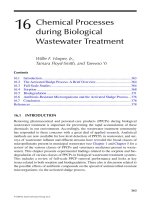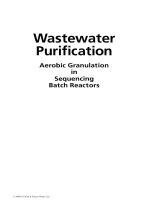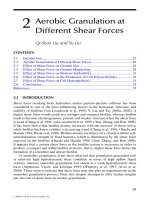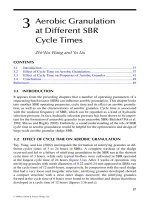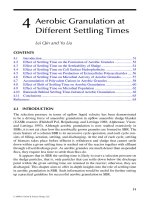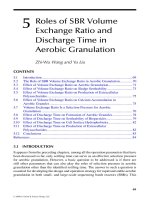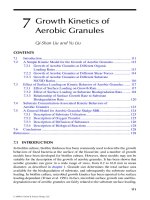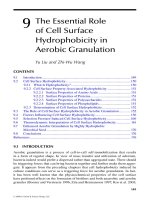Wastewater Purification: Aerobic Granulation in Sequencing Batch Reactors - Chapter 17 (end) doc
Bạn đang xem bản rút gọn của tài liệu. Xem và tải ngay bản đầy đủ của tài liệu tại đây (366.17 KB, 11 trang )
301
17
Pilot Study of Aerobic
Granulation for
Wastewater Treatment
Qi-Shan Liu and Yu Liu
CONTENTS
17.1 Introduction 301
17.2 Startup of Pilot-Scale Aerobic Granular Sludge SBRs 302
17.2.1 Comparison of Pilot- and Laboratory-Scale SBRs 302
17.2.2 CharacteristicsofAerobicGranulesDevelopedinPilot-and
Laboratory-Scale SBRs 305
17.2.2.1 Granule Size and Morphology 305
17.2.2.2 Settling Property 305
17.2.2.3 Physical Strength 306
17.2.2.4 Microbial activity 306
17.3 Startup of a Pilot-Scale SBR Using Stored Granules as Seed 306
17.4 Startup of a Pilot-Scale SBR Using Activated Sludge as Seed 310
17.5 Conclusions 311
References 311
17.1 INTRODUCTION
Aerobic granulation technology has been applied for the high-efciency treatment of a
wide variety of wastewater including toxic wastewater, and it has been demonstrated
inpilot-scaleplants(deBruinetal.2004;deKreuk,deBruin,andvanLoosdrecht
2004;Liuetal.2005),whileitsfullscaleapplicationhasnotyetbeenreported.
In industrial practice, the fast and easy startup of upow anaerobic sludge blanket
(UASB) reactors can be realized by seeding anaerobic granules directly into the
reactor.Thiswillsignicantlyreducethetimerequiredforanaerobicgranulation
whichusuallytakes2to8months.Asimilarstartupstrategyisalsoapplicable
in initiating aerobic granular sludge sequencing batch reactors (SBRs). Existing
evidenceshowsthataerobicgranulescanbestoredoveraperiodof7weeks,andits
activity quickly recovered (Zhu and Wilderer 2003), while J. H. Tay, Liu, and Liu
(2002)alsofoundthataerobicgranulescanbestablystoredfor4monthsat4°C.
Thesendingssuggestthatuseofthestoredaerobicgranulesasseedwouldbe
feasible in full-scale operation of aerobic granular sludge SBRs.
53671_C017.indd 301 10/29/07 7:52:42 AM
© 2008 by Taylor & Francis Group, LLC
© 2008 by Taylor & Francis Group, LLC
302 Wastewater Purification
17.2 STARTUP OF PILOT-SCALE AEROBIC GRANULAR
SLUDGE SBRS
J.H.Tayetal.(2004)investigatedaerobicgranulationinapilot-scaleSBR.The
pilot-scale aerobic granular sludge SBR was initiated by seeding mature aerobic
granules harvested from a laboratory-scale SBR.
17.2.1 COMPARISON OF PILOT- AND LABORATORY-SCALE SBRS
Theseedaerobicgranulesusedinthepilotstudyhadameandiameterof0.83mm
(gure 17.1A). It was found that aerobic granules tended to disintegrate shortly after
seedingintothepilot-scaleSBR,andlooseocsbecamedominantinthereactor
onday5(gure17.1B).Asaresult,themeandiameterofbioparticlesdecreased
to0.19mmandthesludgevolumeindex(SVI)increasedfrom19to175mLg
–1
(gure 17.2A). However, compact aggregates were gradually re-formed on day 20,
indicatedbyameandiameterof0.4mmandanSVIof63mLg
–1
(gure 17.1C).
Thegranulesizecontinuedtoincreaseuptoapeakvalueof1.4mmonday50,and
nallystabilizedatthislevelwithanSVIofaround26mLg
–1
(gure 17.2A). It can
beseenthatthesteady-stategranulesinthepilot-scaleSBRhadacompactstructure
similartotheseedgranules,buttheywerelargerinsize(gure17.1AandD).Unlike
theevolutionofaerobicgranulesinthepilot-scaleSBR,aerobicgranulesinthelabo
-
ratory-scale SBR remained stable throughout the whole study period, indicated by
relativelyconstantgranulesizeandSVI,andtherewasanincreaseinsizeduringthe
rst 2 weeks (gure 17.2B).
AB
CD
FIGURE 17.1 Morphologyofbioparticlesinthepilot-scaleSBRatday1(A),day5(B),
day20(C),andday65(D).Scalebar:4mm.(FromTay,J.H.etal.2004.Proceedings of
Workshop on Aerobic Granular Sludge, Munich, Germany.Withpermission.)
53671_C017.indd 302 10/29/07 7:52:43 AM
© 2008 by Taylor & Francis Group, LLC
© 2008 by Taylor & Francis Group, LLC
Pilot Study of Aerobic Granulation for Wastewater Treatment 303
Theinitialincreaseingranulesizeinthelaboratory-scaleSBRwasprobablydueto
Low biomass concentration would lead to fewer collisions among granules and
weaker detachment from individual granule. Difference in granule size observed in
the pilot- and laboratory-scale SBRs at steady state can likely be attributed to differ-
entshearanddetachmentforcesinthetworeactors.Figure17.4showsthatmorebio-
mass was retained in the bottom half of the laboratory-scale SBR, whereas an even
biomass distribution was observed in the pilot-scale SBR. The high accumulation of
granular sludge at the bottom of the laboratory-scale SBR would certainly increase
the collision and detachment rate among the granule particles. Consequently, smaller
granules were developed in the laboratory-scale SBR. As discussed in chapter 2, the
size of aerobic granules is inversely correlated to the shear force generated by the
airbubblesandcollisionsamongthesludgeparticles(J.H.Tay,Liu,andLiu2004).
Thesizeofthegranulesdevelopedinthestablelaboratory-scaleSBRwassimilarto
the seed granules (gure 17.2). The similarity in size is not unexpected because the
reactor conguration and operating conditions were similar in the laboratory-scale
SBR and the reactor used for precultivation of seed granules.
The biomass concentration in both pilot- and laboratory-scale SBRs was the
sameatthelevelof0.4gL
–1
tration tended to gradually increase to 6.5 g L
–1
intherst3weeksofoperationin
both reactors. A drop in biomass concentration was observed in the period of day 30
0.5
1.0
1.5
2.0
Sludge Size (mm)
50
100
150
200
A
0.0
0.5
1.0
1.5
0 102030405060708090
100
Time (days)
Sludge Size (mm)
0
50
100
150
B
0.0
0
SVI (mL g
–1
)
SVI (mL g
–1
)
FIGURE 17.2 Changesinmeandiameter(D)andSVI($)ofbioparticlesinthecourseof
operationofapilot-scaleSBR(A)andalaboratory-scaleSBR(B).(DatafromTay,J.H.etal.
2004. Proceedings of Workshop on Aerobic Granular Sludge, Munich, Germany.)
53671_C017.indd 303 10/29/07 7:52:45 AM
© 2008 by Taylor & Francis Group, LLC
© 2008 by Taylor & Francis Group, LLC
the relatively low sludge concentration when the reactor was started up (gure 17.3B).
at the reactor startup (gure 17.3). The biomass concen-
304 Wastewater Purification
to40,whichresultedfromareducedsettlingtimeintheSBRfrom5to2min.Obvi-
ously, this would cause the washout of slow-settling sludge, leading to a temporary
reductioninbiomassconcentration.Ontheotherhand,theshortersettlingtimealso
exerted a stronger selection pressure on biomass, which in turn encourages the reten
-
tion of biomass with excellent settleability, as discussed in chapter 6. Consequently,
the biomass concentration gradually increased over time and nally stabilized at
8.0gL
–1
in both reactors. These results seem to indicate that the seed granules
in the laboratory-scale SBR can be successfully maintained, and new granules can
growimmediatelyafterthereactorstartup,whilegranulescanbelostbutre-formed
shortlyfromdisintegratedgranulesinthepilot-scaleSBR.
The distribution of biomass concentration along the reactor height was different
in the pilot- and laboratory-scale SBRs (gure 17.4). The biomass was distributed
rather evenly along the reactor height in the pilot-scale SBR, whereas more biomass
was accumulated in the lower half of the laboratory-scale SBR. This may be due to
the difference of hydrodynamic conditions in the two reactors. It is believed that the
initial disappearance of aerobic granules and dominant growth of bioocs in the
pilot-scaleSBRwaslikelylinkedtotheprevailinghydrodynamicconditionsdueto
different reactor diameters. Moreover, the size and location of air diffusers in the
column SBR would also affect the hydrodynamic ow pattern. However, the cycle
2
4
6
8
10
0
2
4
6
8
0 102030405060708090100
Time (days)
B
0
A
MLSS (g L
–1
)MLSS (g L
–1
)
FIGURE 17.3 Sludge concentration versus time in pilot-scale (A) and laboratory-scale (B)
SBRs. (From Tay, J. H. et al. 2004. Proceedings of Workshop on Aerobic Granular Sludge,
Munich, Germany.)
53671_C017.indd 304 10/29/07 7:52:46 AM
© 2008 by Taylor & Francis Group, LLC
© 2008 by Taylor & Francis Group, LLC
Pilot Study of Aerobic Granulation for Wastewater Treatment 305
operation of SBR provides a selective process that allows for the gradual redevelop-
mentofgranularbiomasswithgoodsettlingcharacteristics.Forinstance,ashort
settlingtimepromotestheselectionoffast-settlingbioparticles.
17.2.2 CHARACTERISTICS OF AEROBIC GRANULES DEVELOPED IN
P
ILOT- AND LABORATORY-SCALE SBRS
17.2.2.1 Granule Size and Morphology
Themeandiameterofaerobicgranulesdevelopedinthepilot-scaleSBRwas1.37mm
0.83mm.Aerobicgranulescultivatedinthelaboratory-scaleSBRhadasimilarsize
astheseedgranules.Thesetwokindsofaerobicgranulesexhibitedasimilarmor
-
phologyintermsofaspectratioandroundness.Infact,averywidesizerangeof
aerobicgranuleshasbeenreported,from0.2mmupto16mm(Morgenrothetal.
1997;J.H.Tay,Liu,andLiu2001;Zhengetal.2006).
17.2.2.2 Settling Property
Aerobicgranulesinthepilot-scaleSBRhadanSVIaslowas26.5mLg
–1
andahigh
specicgravityof1.017,whiletheSVIwas34.4mLg
–1
andspecicgravitywas
1.015forthosegranulescultivatedinthelaboratory-scaleSBR.Thevolatilesolids
contentofgranulesinthepilot-scaleSBR(62.4%)waslowerthanthatofgranules
cultivatedinthelaboratory-scaleSBR(74.9%).Thisindicatesasignicantaccumu
-
lation of inorganic materials in the granules developed in the pilot-scale SBR. The
higherinorganiccontentwaspartiallyresponsiblefortheobservedlowSVI.
0
20
40
60
80
100
120
140
012345
Reactor Height (cm)
0
20
40
60
80
100
120
140
0102030
Reactor Height (cm)
Biomass Concentration (g L
–1
)
(b)(a)
Biomass Concentration (g L
–1
)
FIGURE 17.4 Sludge distribution along the reactor height during the rst day (A) and at
steady state (B). D:pilot-scaleSBR; : laboratory-scale SBR. (From Tay, J. H. et al. 2004.
Proceedings of Workshop on Aerobic Granular Sludge, Munich, Germany.)
53671_C017.indd 305 10/29/07 7:52:47 AM
© 2008 by Taylor & Francis Group, LLC
© 2008 by Taylor & Francis Group, LLC
(table17.1),whichwaslargerthanthatoftheseedgranuleswithatypicalsizeof
306 Wastewater Purification
17.2.2.3 Physical Strength
Thephysicalstrengthofaerobicgranules,expressedasintegritycoefcient,was
96.0% in the pilot-scale SBR and 96.9% in the laboratory-scale SBR, that is, aerobic
granulesdevelopedinthelaboratory-scaleSBRwerecomparablewiththoseinthe
pilot-scale SBR.
17.2.2.4 Microbial activity
The specic oxygen uptake rate (SOUR) as an indicator of microbial activity was
74.1 mg O
2
g
–1
volatile suspended solids (VSS) h
–1
forgranulesinthepilot-scaleSBR
and80.6mgO
2
g
–1
VSS h
–1
for the granules in the laboratory-scale SBR (table 17.1).
The slightly low microbial activity of aerobic granules in the pilot-scale SBR is
thoughttobesize-related.Infact,thelimitationofmasstransportanddiffusionis
generallymorepronouncedforlargergranules,whichwouldresultinlowmicrobial
activity,asdiscussedinchapter8.Itisapparentthatuseoffreshaerobicgranulesas
seed is feasible to quickly start up an aerobic granular sludge SBR.
17.3 STARTUP OF A PILOT-SCALE SBR USING
STORED GRANULES AS SEED
Liuetal.(2005)usedaerobicgranulesthathadbeenstoredfor4monthstoinitiate
apilot-scaleSBR,andfoundthattheseedgranulesweremaintainedstably,andnew
granulescouldbesuccessfullyformedthereafter.Thesizeofgranulesgradually
increasedfrom1.28to1.7mmwithin1week(gure17.5),andthendecreasedtoa
size similar to the seed granules. Similar to gure 17.2B, the initial increase in granule
sizeisduetothefewercollisionsamonggranulesandsubsequentweakdetachment,
becauseoflowbiomassconcentrationinthereactorintheinitialperiod.Newgranules
begantoformafterday5,andbiomassconcentrationgraduallyincreasedaccordingly
(gure 17.6).
TABLE 17.1
Characteristics of Aerobic Granules Cultivated in
Pilot-Scale and Laboratory-Scale SBRs.
Items Pilot-Scale SBR Laboratory-Scale SBR
Mean diameter (mm) 1.37 (± 0.09) 0.89 (± 0.07)
Aspect ratio 0.67 (± 0.16) 0.69 (± 0.15)
Roundness 0.69 (± 0.15) 0.69 (± 0.16)
SVI (mL g
–1
) 26.5 (± 5.9) 34.4 (± 6.9)
Specic gravity 1.017 (± 0.0005) 1.015 (± 0.0005)
VSS/SS (%) 62.4 (± 2.8) 74.9 (± 3.6)
Integrity coefcient (%) 96.0 (± 2.0) 96.9 (± 2.5)
SOUR (mg O
2
g
–1
VSS h
–1
) 74.1 (± 12.4) 80.6 (± 18.2)
53671_C017.indd 306 10/29/07 7:52:47 AM
© 2008 by Taylor & Francis Group, LLC
© 2008 by Taylor & Francis Group, LLC
Pilot Study of Aerobic Granulation for Wastewater Treatment 307
Abiomassconcentrationofthestoredaerobicgranulesof1.03gL
–1
was initially
seeded into the pilot-scale SBR, and remained unchanged in the rst 4 days. After-
wards,itgraduallyincreasedtoastablelevelof6.0gL
–1
.Itshouldbepointedoutthat
the pilot-scale SBR was initiated with an initial biomass concentration of 1.03 g L
–1
andlowinuentCODof400mgL
–1
.Thisresultedinagranulesurfaceloading
rateof8.7gCODm
–2
d
–1
at the beginning of the study, as shown in gure 17.7. The
granulesurfaceloadingratethenuctuatedfrom6.5to11.0gCODm
–2
d
–1
till day 6,
depending upon the biomass concentration in the reactor and the organic loading
rate applied. At steady state, the surface loading rate dropped to 1.4 g COD m
–2
d
–1
because of the high biomass concentration in the reactor. It is mostly likely that a
highgranulesurfaceloadingratewouldpromotethegrowthofsuspendedbacterial
cellsinsteadofgranules.Thus,alowgranulesurfaceloadingratemightbeapplied
forthereactorstartupinordertopreventtheoutgrowthofsludgeocs,particularly
during the initial period.
1.0
1.2
1.4
1.6
1.8
0 10203040
Time (days)
Size (mm)
FIGURE 17.5 Sludge particle size versus operation time in the pilot-scale SBR. (From
Liu,Q S.etal.2005.Environ Technol 26:1363–1369.Withpermission.)
0.0
2.0
4.0
6.0
8.0
0 10203040
Time (days)
0
50
100
150
200
250
SVI (mL g
–1
)
Biomass Concentration (g L
–1
)
FIGURE 17.6 Biomass concentration ( )andSVI(D) versus operation time in the pilot-
scaleSBR.(FromLiu,Q S.etal.2005.Environ Technol 26:1363–1369.Withpermission.)
53671_C017.indd 307 10/29/07 7:52:49 AM
© 2008 by Taylor & Francis Group, LLC
© 2008 by Taylor & Francis Group, LLC
308 Wastewater Purification
Theseedaerobicgranulesafter4monthsofstoragehadaSOURof13.4mgO
2
g
–1
VSS h
–1
(gure 17.8). After 2 days of cultivation in the pilot-scale SBR, the SOUR
increasedto94.5mgO
2
g
–1
VSS h
–1
, which is comparable to that of fresh aerobic
granules. These results clearly showed that the stored aerobic granules can be revived
withafullrecoveryofmicrobialactivitywithin2days.Theshortrecoverytimeof
themicrobialactivityofstoredgranuleswouldbeverymuchadvantageousforits
applicationinindustrialpractice.Seedgranuleshadalightgreycolorwithablack
core (gure 17.9A), which is suspected to be due to the sulde generated by sulfate-
reducing bacteria during storage, while fresh aerobic granules often have brown
-
ish-yellow color. However, after 2 days of reviving, the apparent color of the stored
Figure 17.10 shows the reactor performance of the pilot-scale SBR in terms of
inuent and efuent COD. The reactor was initiated by supplying an inuent COD
of400mgL
–1
,andaftertherstSBRcycle,theefuentCODwas173mgL
–1
.With
FIGURE 17.8 Activityrecoveryofstoredaerobicgranulesduringtheoperationofthepilot-
scaleSBR.(FromLiu,Q S.etal.2005.Environ Technol 26:1363–1369.Withpermission.)
0.0
4.0
8.0
12.0
040302010
Time (days)
Surface Loading Rate (g m
–2
d
–1
)
FIGURE 17.7 Granule surface loading rate versus operation time. (From Liu, Q S. et al.
2005. Environ Technol 26:1363–1369.Withpermission.)
53671_C017.indd 308 10/29/07 7:52:50 AM
© 2008 by Taylor & Francis Group, LLC
© 2008 by Taylor & Francis Group, LLC
aerobicgranulesturnedtothatoffreshgranules(gure17.9B).
0
50
100
150
200
0 10 20 30 40
Time (days)
SOUR (mg O
2
g
–1
h
–1
)
Pilot Study of Aerobic Granulation for Wastewater Treatment 309
the gradual recovery of granule microbial activity, the efuent COD decreased to
82 mg L
–1
after1dayofSBRoperation,andfurtherto60mgL
–1
at the end of the
second day. The inuent COD was increased to 550 mg L
–1
onday4andfurtherto
800mgL
–1
onday7becauseaerobicgranuleactivityhadbeenfullyrecoveredand
newgranuledevelopmentwasalsoobserved.Itappearsfromgure17.10thatthe
increase in the inuent COD had little impact on the removal efciency, and stable
efuent COD concentration of 37 mg L
–1
was recorded, corresponding to a COD
removal efciency of 96%.
Successfulstartupofthepilot-scaleaerobicgranularsludgeSBRbyseeding
stored granules was demonstrated to be feasible. The microbial activity of stored
granulescanfullyrecoveredwithin2days.Infact,thegranulescultivatedfrom
benign substrates, such as acetate, can be used as the microbial seeds to produce
granules to degrade toxic substrates, such as phenol (S. T. L. Tay et al. 2005). This
FIGURE 17.9 Apparentcolorsofstoredaerobicgranules(A)andthoseafter2daysof
reviving (B). (From Liu, Q S. et al. 2005. Environ Technol 26:1363–1369.Withpermission.)
0
200
400
600
800
1000
0 10203040
Time (days)
COD Concentration (mg L
–1
)
FIGURE 17.10 COD concentration proles observed in the pilot-scale SBR seeded with
stored aerobic granules.
: inuent; D:efuent.(FromLiu,Q S.etal.2005.Environ Technol
26:1363–1369.Withpermission.)
53671_C017.indd 309 10/29/07 7:52:51 AM
© 2008 by Taylor & Francis Group, LLC
© 2008 by Taylor & Francis Group, LLC
310 Wastewater Purification
furtherextendstheapplicationofseedgranulestoothertypesofwastewaterortoxic
wastewater treatment.
17.4 STARTUP OF A PILOT-SCALE SBR USING
ACTIVATED SLUDGE AS SEED
Aerobic granulation directly from activated sludge ocs with municipal wastewater
wassuccessfullydemonstratedinapilot-scaleplantintheNetherlands(DeBruin
etal.2004).TwocolumnSBRs6minheightand0.6mindiameterwereoperated
in parallel treating wastewater at a ow rate of 5.0 m
3
h
–1
(gure 17.11). Forma-
tionofaerobicgranuleswithanSVIof55mLg
–1
couldtakeplaceinafewweeks.
Granularsludgealsohadagoodcapabilityfortheremovalofnitrogenandphosphate
present in the municipal wastewater. It was found that pretreatment to remove sus
-
pendedsolidparticlesinordertoimprovegranulationandthepost-treatmentmight
be needed so as to satisfy the stringent discharge limits. It appears that there will be
noproblemforaerobicgranulationfrombioocsinpilot-scaleSBRs.
Two parallel
column reactors
FIGURE 17.11 AerobicgranularsludgepilotplantinstalledintheNetherlands.(From
DeKreuk,M.K.,DeBruin,L.M.M.,andvanLoosdrecht,M.C.M.,2004.Paperpresented
at IWA Workshop on Aerobic Granular Sludge, Munich, Germany.)
53671_C017.indd 310 10/29/07 7:52:53 AM
© 2008 by Taylor & Francis Group, LLC
© 2008 by Taylor & Francis Group, LLC
Pilot Study of Aerobic Granulation for Wastewater Treatment 311
17.5 CONCLUSIONS
Aerobicgranulationinpilot-scaleSBRsisanimportantstepforitsfullapplication
intheindustrial-scaleplant.AerobicgranularsludgeSBRscanbeinitiatedbyseed-
ing either fresh or stored aerobic granules. The microbial activity of stored aerobic
granulescanbequicklyrecoveredwithinashorttimeof2days.Meanwhile,aerobic
granulationdirectlyfrombioocsasseedhasalsobeendemonstratedinthepilot
plant. Results from the pilot studies show that aerobic granulation is a promising
technology for wastewater treatment due to its compact footprint, lower sludge pro-
duction, and simultaneous organic and nutrient removal.
REFERENCES
deBruin,L.M.M.,vanDerRoest,H.F.,DeKreuk,M.K.,andvanLoosdrecht,M.C.M.
2004. Promising result pilot plant research aerobic granular sludge technology at
WWTP. Paper presented at IWA Workshop on Aerobic Granular Sludge, September
27–28. Munich, Germany.
deKreuk,M.K.,DeBruin,L.M.M.,andvanLoosdrecht,M.C.M.2004.Aerobicgranular
sludge: From idea to pilot plant. Paper presented at IWA Workshop on Aerobic Granular
Sludge, September 27–28. Munich, Germany.
Liu, Q S., Liu, Y., Tay, S. T. L., Show, K. Y., Ivanov, V., Benjamin, M., and Tay, J. H. 2005.
Startup of pilot-scale aerobic granular sludge reactor by stored granules.
Environ
Technol 26: 1363–1369.
Morgenroth, E., Sherden, T., van Loosdrecht, M. C. M., Heijnen, J. J., and Wilderer, P. A.
1997. Aerobic granular sludge in a sequencing batch reactor.
Water Res 31: 3191–3194.
Tay,J.H.,Liu,Q S.,andLiu,Y.2001.Microscopicobservationofaerobicgranulationin
sequential aerobic sludge blanket reactor.
J Appl Microbiol 91: 168–175.
Tay, J. H., Liu, Q S., and Liu, Y. 2002. Characteristics of aerobic granules grown on
glucose and acetate in sequential aerobic sludge blanket reactors.
Environ Technol
23: 931–936.
Tay,J.H.,Liu,Q S.,andLiu,Y.2004.Theeffectofupowairvelocityonthestructure
ofaerobicgranulescultivatedinasequencingbatchreactor.
Water Sci Technol
49: 35–40.
Tay,J.H.,Liu,Q S.,Liu,Y.,Show,K.Y.,Ivanov,V.,andTay,S.T.L.2004.Acomparative
studyofaerobicgranulationinpilot-andlaboratory-scaleSBRs.Proceedingsof
Workshop on Aerobic Granular Sludge, September 27–28. Munich, Germany.
Tay,S.T.L.,Moy,B.Y.P.,Jiang,H.L.,andTay,J.H.2005.Rapidcultivationofstableaerobic
phenol-degrading granules using acetate-fed granules as microbial seed. JBiotechnol
115: 387–395.
Zheng,Y.M.,Yu,H.Q.,Liu,S.H.,andLiu,X.Z.2006.Formationandinstabilityofaerobic
granules under high organic loading conditions.
Chemosphere 63: 1791–1800.
Zhu,J.R.andWilderer,P.A.2003.Effectofextendedidleconditionsonstructureand
activity of granular activated sludge.
Water Res 37: 2013–2018.
53671_C017.indd 311 10/29/07 7:52:53 AM
© 2008 by Taylor & Francis Group, LLC
© 2008 by Taylor & Francis Group, LLC
